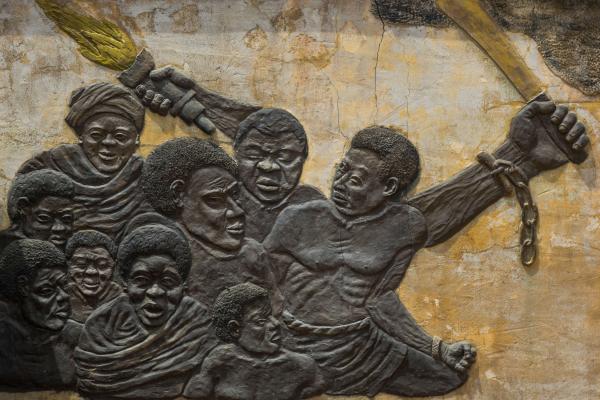This March, U.S. Customs and Border Protection agents encountered nearly 19,000 unaccompanied minors at the U.S.-Mexico border — a record high. To many, this number was shocking; media outlets used militaristic language to describe the arriving minors as a “surge.” However, this influx is not surprising given seasonal migration patterns and the horrific immigration policies instated by the Trump administration — policies the Biden administration has not yet repealed. The current administration must address the immediate needs of people seeking refuge at the southern border while also tackling the root causes of forced displacement and migration: U.S. imperialism.
Earlier this week, we heard echoes of this imperialism as the Biden administration reached agreements with Latin American nations to implement militarized solutions to the forced displacement crisis. Mexico, Guatemala, and Honduras agreed to deploy 10,000, 1,500, and 7,000 of their own troops, respectively, to their borders, meeting this so-called “surge” in migration with an actual surge in troops. Liberating our geopolitical imagination begins with ending the use of militaristic terms when we discuss migration.
To understand why there are so many unaccompanied minors at the border today, we need to rewind to the start of the pandemic. On March 20, 2020 the Trump administration implemented section 265 of Title 42 under U.S. health law, citing COVID-19 concerns. This action effectively closed the Southern Border to people seeking asylum — including unaccompanied children — by allowing officials to immediately expel asylum-seekers back to Mexico or their countries of origin, even though health experts, including the top doctor at the Centers for Disease Control and Prevention who oversaw such decisions, said there was no health rationale to do so. This decision placed unaccompanied children at greater risk by immediately sending them back to the dangers they fled, including violence and exploitation—a violation of the Trafficking Victims Protection Act. The act ensures non-Canadian and non-Mexican unaccompanied children can be adequately assessed and cared for in the U.S. as their cases proceed.
In January, the Biden administration opted to stop expelling unaccompanied children under Title 42. But even though unaccompanied minors are now allowed to remain, they still are not safe. When children arrive, they are first held in crowded temporary holding spaces; some of these facilities are known in immigrant communities as hieleras or “freezers.” Many children are warehoused in these spaces for far longer than 72 hours, the maximum time permitted. Afterward many children are transferred to large-scale, unlicensed influx facilities, including military bases and facilities that have been accused of physical and sexual abuse in the past.
It doesn’t have to be this way: Given that more than 80 percent of unaccompanied minors have a relative in the U.S. — and for many of these children, that relative is a parent or legal guardian — the administration could work safely to identify and vet these caregivers rather than sending children to influx facilities. If a parent or relative cannot be found within the 72-hour limit, the government could prioritize small-scale, non-restrictive facilities licensed for childcare to ensure the best care possible for this vulnerable population.
Meanwhile, the rest of Title 42 remains in effect, which means the southern border remains closed to many families and single adults arriving today to seek asylum; according to data provided by U.S. Customs and Border Protections, in March alone there were 101,897 people expelled under Title 42. The administration must suspend the use of Title 42 and restore the asylum process by using COVID-19 testing before admitting asylum seekers, providing personal protective equipment to workers at ports of entry, practicing social distance and — most importantly — relying on community-based, cost-effective alternatives to detention.
Ending Title 42 would ease the “surge” of unaccompanied minors at the border, but ultimately, we must deal with the root causes of the problem. When it comes to migration, the U.S. continually fails to recognize that the problem does not begin at the border, but rather in the long-lasting effects of colonialism, U.S. imperialism, climate change, and a reduced imagination of what development and flourishing can really be. Beginning with the Monroe Doctrine in 1823, which positioned the U.S. as the self-proclaimed possessor and protector of the Americas, and later expanded by the Roosevelt corollary, U.S. imperialism has sought to influence, dominate, and control the culture, politics, and economies of countries in the Americas and beyond.
For example, in the first quarter of the 20th century, U.S. Marines often intervened in Central America to protect U.S. businesses amid political crises in the region. In Guatemala, the CIA backed a coup against President Jacobo Arbenz in 1954. In El Salvador, the U.S. funded military and economic aid in the ’80s and helped the government fuel a war to suppress leftist revolutionaries seeking justice against the elites that controlled the country. And as recently as 2009, when Honduran President Manuel Zelaya was unconstitutionally overthrown by the military, the U.S. continued supplying aid to the country without condemning the anti-democratic coup. The impacts of these actions have long-standing consequences that contribute to the forced displacement and migration of Central American people.
In 2018, Nicaraguan poet and activist Gioconda Belli tweeted, “La solidaridad ES la ternura de los pueblos,” or “Solidarity is the tenderness of nations” (author’s translation). She reminds us of a more human approach to international relations. To address the vastness of this problem in the Americas, we could begin by imagining what tenderness and mutuality between the U.S., Honduras, Guatemala, El Salvador, and Mexico might look like.
Robust solutions will need to include a revision of foreign policy. Sojourners participates in a working group led by Comunidades de Fe Organizadas para la Acción El Salvador, Familia Franciscana Guatemala, Organización Fraternal Negra Hondureña, Faith in Action, the Hope Border Institute, and others; this group proposes addressing the root causes of migration by ensuring aid to Central American countries focuses on community development programs led by local leaders rather than the military. The group also recommends that U.S. trade and investment in the region should prioritize the creation of a sustainable workforce rather than the extraction of resources and the promotion of low-wage jobs. Instead of militarized borders, this group suggests a regional asylum system that could be rebuilt to allow those fleeing persecution in their home countries to seek the protections available to other refugees worldwide through the UN High Commissioner for Refugees. Lastly, the group believes the U.S. should restore and expand pathways for people to migrate legally and safely, whether to reunite with their families or to find work.
We must remain committed to liberating our geopolitical imaginations so that together we can build a safer and increasingly thriving world for all.
Got something to say about what you're reading? We value your feedback!








